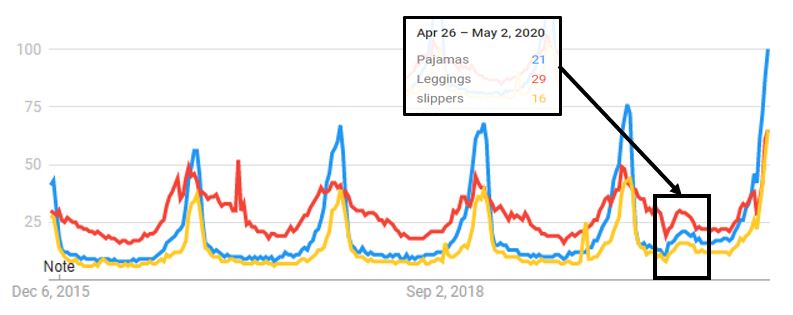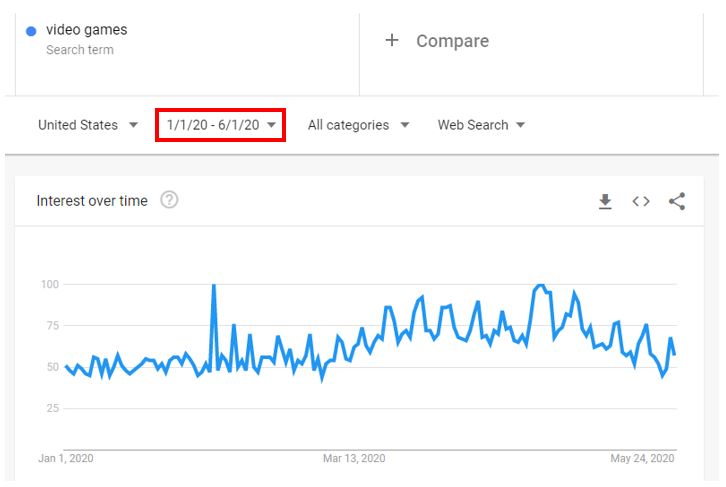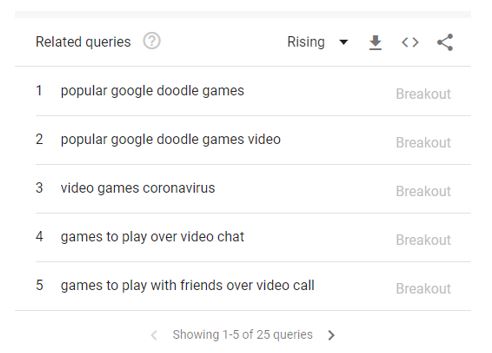Trend analysis has always been a big part of marketing.
Understanding the underlying causes of your target audience’s decision making, and how to leverage those in your favor, is nothing new in our world.
The world is in a massive state of flux right now, which impacts how we move through it and interact with our search bar.
As search experts, we must understand these changes, incorporate those shifts into our strategies, and predict the long-term impacts before they even happen.
So, how do you identify what those shifts are, when they happened, and how to capitalize on them?
That’s what we are going to answer in this article.
And it all starts with trend analysis.
What Is “Trend Analysis”
Trend analysis is understanding fluctuations in users’ search interests and identifying emerging landscape search nuances.
Not sure where to start?
All you need to effectively conduct a pandemic trend analysis is:
- Your brain.
- A free tool.
- A bit of initiative.
Audience Pre-Quarantine vs. Quarantine Search Interest
You may have noticed that your own behaviors have shifted, both offline and online, over the course of the pandemic.
You can assume that your target audiences’ normal behaviors have also shifted.
But how can you know for sure?
You need to look at the only solid data point available: search volume data.
The best way to move through this exercise is to focus on what matters most to us all right now: the impact of COVID-19.
To do that, you must break down the events that might impact your audiences’ search patterns, such as:
- Quarantine – all industries.
- Travel restrictions – travel industries.
- Financial relief efforts – finance, wealth management, & insurance industries.
- Stay-at-home order restrictions gradually lift – regional impacts on all industries.
- Phase two on the horizon – all industries.
Though there may be more nuanced events and impacts from COVID-19, the above list illustrates a handful of events that had widespread impacts that you can analyze to predict how your users may act as we move into a possible second wave of shutdowns.
For the purpose of this walkthrough, let’s focus on “quarantine” and how the impact of the first quarantine (March 2020) may help predict users’ interests moving into the second quarantine.
Leverage Trend Analysis in Shifting Landscapes
If you don’t already know your typical search audiences’ interest seasonality, that’s where you’ll need to start.
The goal is to understand the change in typical search behavior caused by quarantine, so you will need to understand the difference between “usual” vs. “unusual” search.
If you need a refresher on how to identify “usual” search audience interest seasonality, check out Search Audiences & User Intent: SEO’s Secret Weapon and Top 10 Tools for Bulletproof SEO Content Strategies to understand the best way to leverage SEO tools for content strategies.
Once you have your baseline search audience profile, you can start to understand what’s changed and considered “unusual.”
Understand COVID-19 Impact on Search Audiences
COVID-19 presumably hit your search audiences the hardest with the widespread quarantine back in March 2020.
So, this is the next step in your investigation.
To quickly understand the differences between search interest over time, my “go-to” tool is always Google Trends (PS: it’s free!)
Let’s look at the search interest shifts for the way users spend their time in quarantine life.
The easiest assumption here is that your audience is spending more time at home and looking for things to do.
Let’s dig into Google Trends to confirm:
Search interest in “video games” peaked after widespread lockdown.

This is the largest peak we’ve seen over the past five years, bringing user search interest out of a five-year decline.

“Video game consoles” also experienced this peak, exceeding the search interest of Holiday 2019, and has seen sustained search interest increases, which seem to be poised to skyrocket for the 2020 holiday season.

This quarantine trend extends beyond the entertainment industry.
We see users supplementing their lives with lounge clothing, experimenting in the kitchen (hello, sourdough starters!), creating an outdoor space at home, and even leveling up with more skill-intensive creative hobbies.
Lounge clothes: Typical peak occurs yearly in December around the holidays, though 2020 saw uncharacteristic peaks in March.

Baking: “Baking” saw an enormous surge in interest at the beginning of April 2020 – highly uncharacteristic, since the typical yearly search interest peak is during the holiday season.

Outdoor living: The typical peak occurs around May as the weather begins to create the best outdoor experience; however, the 2020 peak was far above the typical steady peaks seen over the past 5 years.

Creative expression: Creative tools have sustained interest year-round with rarely any search interest “peak” times. March 2020 saw a massive increase, suggesting users were investing in leveling up their skills during their quarantine experience.

Turning Trend Insights Into Action Items
Now that you know the impacts of quarantine on your searchers, you can:
- Reactively service their current needs at the time of disruption.
- Proactively predict the needs that may result from future disruption.
Reactive Action Items From Trend Insights
Before jumping into analysis, it’s important to keep in mind that Google Trends interest charts are relative to the time period selected.
To understand growth due to a disruptor, in this case, quarantine, you need to set the date range to the months during the disruption to make sure your data is compared to the previous period. This will be critical to interpreting the data and extracting actionable insights for your “reactive” action items.
Before you move into the proactive stage, you want to be sure to address users’ existing shifts in needs.
For example, if we go back to the video gaming insights, we know users were more active in gaming at the start of quarantine, demonstrating increased interest in both informational and transactional searches for games and consoles.
Here are the dates I’ve chosen to analyze the “video games” search interest:

Here, our “related queries” data from the API used below will compare interest during this selected six-month time period to the previous six months.
This will also highlight interests for video games that fall outside of our “usual” search interest because Holiday 2019 is included in the compare period, which is the peak search interest time.
From here, we can explore the “related queries” in the Google trends API which allows us to understand exactly what those users are searching at a higher frequency related to “video games,” due to the disruptor.

We can also download the data into excel and dig more granularly into both the “rising” and “top” queries.
Here’s how Google Trends defines each:
“*Top – The most popular search queries. Scoring is on a relative scale where a value of 100 is the most commonly searched query, 50 is a query searched half as often as the most popular query, and so on.
* Rising – Queries with the biggest increase in search frequency since the last time period. Results marked “Breakout” had a tremendous increase, probably because these queries are new and had few (if any) prior searches.”
Looking at the related queries, we can see that users are looking for video games to connect with their friends and family via video games during quarantine and researching the overall “best” games to play during this time:
|
RISING |
|
| video games coronavirus | Breakout |
| games to play over video chat | Breakout |
| games to play with friends over video call | Breakout |
| video games releasing in 2020 | Breakout |
| most played video games right now | 3,700% |
| best video games for quarantine | 1,500% |
| top video games 2020 | 1,050% |
| popular video games 2020 | 950% |
| best video games 2020 | 550% |
| games to play over video call | 350% |
| games to play when bored | 200% |
This suggests that video game brands and retailers should create content and messaging around how video games are great tools to stay connected while staying safe during quarantine and keep boredom at bay.
Proactive Action Items From Trend Insights
A second phase of lockdowns seems inevitable. So you can use the insights you’ve learned from the first quarantine to help prepare for it.
Continuing with the gaming illustration, consumers are clearly experiencing a renewed interest in gaming and, based on search interest trends, are also exploring high-level terms that suggest they want to learn about available options to expand their game collections or console arsenals.
Knowing that holiday is the typical peak season, we can presumably expect that search interest will be higher than usual and be a great new consumer acquisition period.
Content creation and expansion focused on high-funnel topics like gift guides, best lists, and top quarantine games will likely drive awareness with informational queries and capture qualified traffic moving into the holiday season and the second round of shutdowns.
A strong internal linking strategy and information architecture will help move users further down the funnel to conversion.
Summary
Disruptors happen, both big and small.
As an SEO professional, it’s your job to understand how to identify and solve for them.
Paying close attention to your users’ search behaviors allows you to react to changes in a timely manner, capitalize on opportunities, and predict how this may affect future search trends so that you are prepared when the time comes.
Trend analysis can uncover useful insights that lead to valuable data-driven action items, including:
- Content creation and additions.
- Emerging keyword targeting opportunities based on user interests.
- Meta data optimization and iterations.
- Internal linking opportunities.
- Strategy planning and road mapping to account for future implications.
More Resources:
- Google Trends Reveals How Coronavirus Changed Search
- 7 Ways to Use Google Trends for SEO & Content Marketing
- 10 Important 2021 SEO Trends You Need to Know
Image Credits
All screenshots taken by author, December 2020





